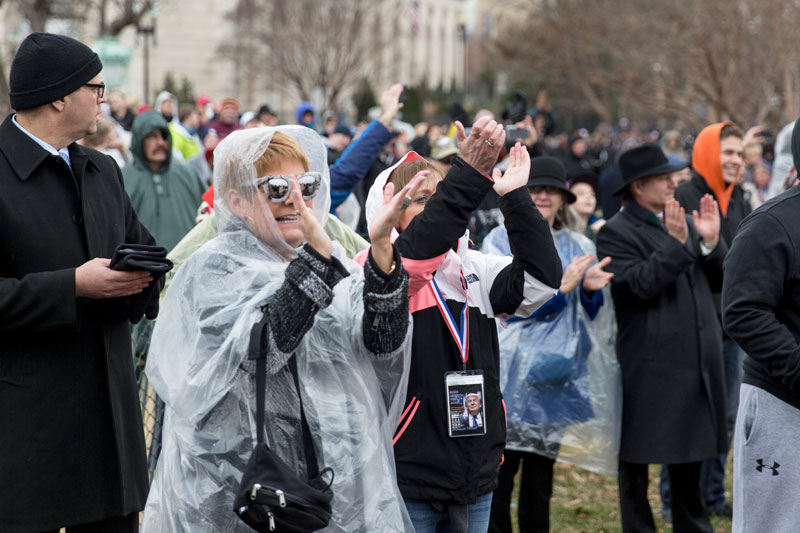 Donald Trump supporters brave the showers to hear the inauguration
Donald Trump supporters brave the showers to hear the inauguration
While Donald Trump did seek advice on his inauguration speech from his campaign speechwriter Stephen Miller, he apparently wrote the final text himself. And although it didn’t follow the traditional rules of rhetoric, the speech followed an interesting metaphoric logic all its own. The effect was to cast his inauguration as an almost messianic moment.
Even before he took the stand, it was clear that Trump wouldn’t stick to rhetorical tradition. The LA Times asked ahead of the ceremony whether the new president would rise to “a level of logic and eloquence that might bring the sceptical around to his view of the nation.” Based on Trump’s rhetorical track record, this was, the same paper admitted, a pipe dream.
The “logic and eloquence” the LA Times hoped for are not what won Trump the presidency; nor are they exactly watchwords of the moment. And indeed, his inaugural wasn’t a particularly memorable speech, rhetorically speaking – but the metaphors the new president employed revealed a lot about his intentions for office.
In classical civilisation, a ship was a common metaphor for rhetoric and the orator, the captain that steers it. When it comes to Trump, it’s tempting to assume that he cannot steer his ship. He doesn’t follow the rules, and his fragmented rhetoric, for all its emotional appeal, is somehow lesser. But it’s also one of the things that got him elected. Lesser or not, it is working somehow.
Writing my inaugural address at the Winter White House, Mar-a-Lago, three weeks ago. Looking forward to Friday. #Inauguration pic.twitter.com/S701FdTCQu
— Donald J. Trump (@realDonaldTrump) January 18, 2017
Trump had just two points to make in his inauguration speech, and he restated them repeatedly in different ways and with different metaphors. First, “America has been exploited overseas, but that ends now, the power is now going back to the people”; second, and building on the first, “when America is united, it’s unstoppable”.
He started off saying: “citizens of America, we are now joined in national effort to rebuild and restore”. And a few lines later, riffing on the construction metaphor, he said: “we now face challenges and hardships”, but we must “get the job done.”
But then, instead of building on this central metaphor, he employed another. There was suddenly almost a messianic overtone to his speech as he began to talk about power. Trump claimed that the “ceremony has special meaning.” It’s “not just a transfer of power from one group in Washington to another… but a transfer of power and giving it back to people.” He then extended this quasi-religious metaphor calling the people “a righteous people and public.”
From this religious language he pivoted to the metaphor of a churchyard, saying “rusted out factories” were “scattered like tombstones” across the country. And then, gaining momentum and forcefully shoving his hand down towards the podium he said “this American carnage stops right here and stops right now”.
Stop the carnage
So how, exactly, will it stop? Trump changed course again, ending up in an almost prophetic vein with a string of new metaphors: “now arrives the hour of action”, “we stand at the birth of new millennium”, “a new national pride will stir ourselves, lift our sights and heal our divisions”.
Trace the progression of these central metaphors and you see an interesting progression. First come the metaphors of building and construction, then the metaphors of death, and finally the metaphors of a prophetic, messianic rebirth via national unity.
Trump made no attempt to tie this rhetoric together with either logic or eloquence, but despite his more-than-occasional incoherence in front of a crowd, the seemingly random collection of metaphors came together very clearly, in particular his idea of the messianic power of the moment. But just when Trump might be expected to say “I have come to save you”, he says instead: “I have come to give you back power.”
So without being rhetorically memorable, the ideas behind his odd collection of metaphors speak volumes. He sees his inauguration as a messianic moment of rebirth, but a rebirth by virtue of handing power to the people. How he will follow that path may be the test of his presidency.![]()
This article was originally published on The Conversation. Read the original article.



Rate and Review
Rate this article
Review this article
Log into OpenLearn to leave reviews and join in the conversation.
Article reviews